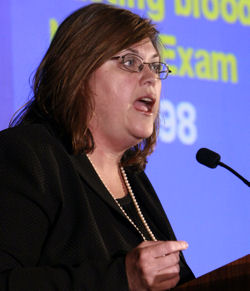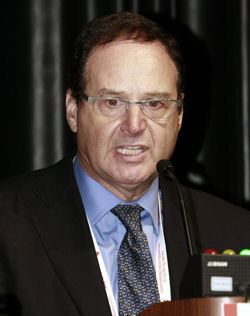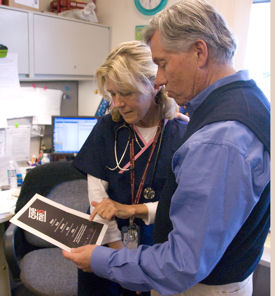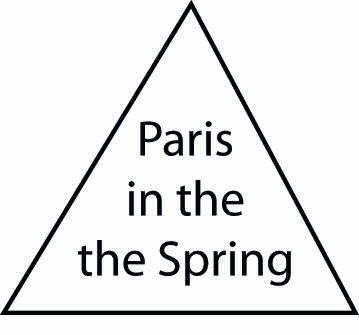Recognize and react is theme underlying latest stroke studies
Conference coverage focuses on studies about abdominal obesity, symptoms and the importance of dialing 911 first.
NEW ORLEANS—If you're going to have a stroke, please do so during normal business hours.
That was the upshot of a study (see “,” below) at the American Stroke Association's International Stroke Conference 2008, where dozens of abstracts were presented on the risk factors, symptoms and treatment of stroke.
Some results were surprising, such as the conclusion that daytime dozing among the elderly indicates higher stroke risk. Others, like the notion that one gets better care in the emergency department during the weekday than on nights and weekends, were more predictable, but noteworthy nonetheless. Still others offered hope that the current treatment window for thrombolytics might be expanded in the not-too-distant future, at least for some patients.
“Many of the studies presented here indicate how to pay attention to certain symptoms, whether there are differences across different (populations), and whether educational programs will improve recognition of stroke symptoms,” said Ralph Sacco, MD, chairman of the stroke advisory committee for the American Stroke Association. “Recognizing stroke signs and symptoms, and getting a swift response, is a vital issue.”
Update on risks and symptoms
Several new studies shed light on stroke risk factors and symptoms. One, which analyzed data from the National Health and Nutrition Surveys, found that the risk of stroke for middle-aged women has tripled in the last decade. Specifically, 0.6% of women aged 35-54 years had strokes in a 1988-1994 survey compared with 1.8% in a 1999-2004 survey.
Women in the latter survey had a higher average waist circumference, higher body-mass index (BMI) and higher average glycated hemoglobin than those in the earlier study. There were no differences in blood pressure, total cholesterol, smoking or heart disease between the two time periods, though women in the latter survey were more likely to report using medication to lower blood pressure or cholesterol.
“Abdominal obesity is a known predictor of stroke in women and may be a key factor in the midlife stroke surge in women,” said study author Amytis Towfighi, MD, assistant professor of neurology at the University of Southern California, noting that her study offers yet another reason to tackle the nation's obesity crisis.
Another study found women are less likely to have specific stroke symptoms than men. An analysis of the medical records of 449 patients with first ischemic stroke in Rochester, Minn. during 1985-1989 found women had more generalized weakness (33% women vs. 21% men), fatigue (31% vs. 21%), mental status changes (44% vs. 24%) and disorientation (31% vs. 21%) than men.
Men more commonly complained of paresthesia (38% men vs. 24% women), ataxia (75% vs. 61%), visual disturbances (12% vs. 6%) and double vision (7% vs. 2%). Ischemic stroke signs also differed by gender, with language disorder and fever more common in women and sensory abnormalities more common in men.
“Men present with more traditional symptoms,” said Jerath Nivedita, a student at the Mayo Clinic Medical School in Rochester, Minn. and lead study researcher. “It's important to recognize these differences in symptoms, so that there can be early treatment for both sexes.”

A novel risk factor was unveiled with the finding that regular daytime dozing—or unintentionally falling asleep—is associated with a higher risk of stroke in elderly patients. In a prospective study of 2,153 patients (average age 73 years), risk of stroke was 2.6 times greater for those who said they did “some dozing” compared with “no dozing” during the day. The risk for those who did “significant dozing” was 4.5 times higher.
“Those are significant numbers,” said Bernadette Boden-Albala, PhD, lead author of the study and assistant professor of neurology at Columbia University College of Physicians and Surgeons in New York. “It's worth assessing patients for sleep problems. … If patients are moderately or significantly dozing, physicians need to think about sending them for further evaluation.”
Stroke awareness: an ongoing struggle
More than one study suggested that front-office staff are not as familiar with stroke symptoms as physicians would like to think.
An Australian abstract found that, in 22% of cases, a patient or bystander's first response to stroke symptoms was to call a doctor, not an ambulance. Once the doctor's office was called, patients were advised to come in for a visit rather than call emergency services 36% of the time. A U.S. study, meanwhile, found similar results: nearly one-third of primary care practices that were called by researchers seeking advice on hypothetical stroke symptoms recommended scheduling an appointment later in the day if symptoms persisted, rather than calling 911.
In both cases, researchers concluded medical office staff members need more education on the importance of detecting stroke symptoms and on advising patients to call 911 immediately, in order to get prompt treatment. Indeed, the Australian study found that calling a doctor's office first with stroke symptoms greatly lengthened the time before a patient ultimately reached the hospital.

“Calling 911 is the only correct answer,” said Stephen Davis, co-author of the U.S. study and adjunct assistant professor of emergency medicine at West Virginia University-Morgantown.
A separate study showed that unilateral symptoms and speech problems brought patients to the emergency department fastest. The study, which looked at patient charts for 1,922 stroke admissions from six Michigan hospitals, found visual disturbances and confusion were associated with later arrival, along with difficulty walking, balance and/or dizziness, and non-headache pain.
These results were somewhat confounded, however, by a study of medical records for 2,056 stroke and transient ischemic attack patients in the Cincinnati area, about 45% of whom used emergency medical services. Those with confusion/decreased level of consciousness were 60% more likely to call EMS, and those with weakness were 50% more likely. Patients with numbness were 40% less likely to call, while headache wasn't associated with EMS use at all.
“My take-away from this is that we need to be sure to mention sudden headache and numbness as symptoms,” in stroke awareness and education efforts, said Dawn Kleindorfer, MD, neurologist and lead author of the latter study.
Treatment timing is everything
Quality treatment for stroke doesn't just vary by facility; one study suggested it varies within facilities as well.
Stroke patients who come to the hospital at night and on weekends were more likely to die there than those treated in daytime hours and during the week, one study found. Using data from 222,514 acute stroke admissions at 857 hospitals between 2003 and 2007, researchers discovered that about 24% of hemorrhagic stroke patients who arrived in the emergency department between 7 a.m. and 6 p.m. on weekdays died compared with 27% of hemorrhagic stroke patients who arrived at other times. About 5.2% of ischemic stroke patients died when they came to the hospital during business (weekday) hours compared with 5.8% who arrived off-hours.
Another study of more than 2.4 million U.S. hospital admissions between 1988 and 2004 found that about 7.9% of all stroke patients admitted during the week died compared with 10.1% admitted on weekends. For ischemic stroke patients in particular, mortality was 7.3% on weekdays versus 8.2% on weekends.
Researchers in both studies adjusted for age, race, gender and other factors, which means the disparity could be due to worse staffing and care practices on weekends/off hours—a theory with a silver lining, said David S. Liebeskind, MD, senior author of the second study and associate director of the University of California Los Angeles Stroke Center.
“If this is related to the quality of care, then this could be fixable,” Dr. Liebeskind said.
Potential good news came in the form of a study on tissue plasminogen activator (tPA), when researchers found it might be helpful in certain patients beyond the currently approved window of three hours after ischemic stroke onset.
Of patients who had potentially salvageable brain tissue, about half were assigned tPA and half to placebo three and six hours after acute ischemic stroke onset. There was a strong trend toward lower infarct growth in those who received tPA, though it wasn't significant, and a significant restoration of blood flow at 3-5 days for tPA patients. The study was published in the April 2008 issue of The Lancet Neurology.




